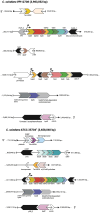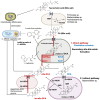Clostridium scindens: history and current outlook for a keystone species in the mammalian gut involved in bile acid and steroid metabolism
- PMID: 40307670
- PMCID: PMC12065433
- DOI: 10.1093/femsre/fuaf016
Clostridium scindens: history and current outlook for a keystone species in the mammalian gut involved in bile acid and steroid metabolism
Abstract
Clostridium scindens is a keystone bacterial species in the mammalian gut that, while low in abundance, has a significant impact on bile acid and steroid metabolism. Numerous studies indicate that the two most studied strains of C. scindens (i.e. ATCC 35704 and VPI 12708) are important for a myriad of physiological processes in the host. We focus on both historical and current microbiological and molecular biology work on the Hylemon-Björkhem pathway and the steroid-17,20-desmolase pathway that were first discovered in C. scindens. Our most recent analysis now calls into question whether strains currently defined as C. scindens represent two separate taxonomic groups. Future directions include developing genetic tools to further explore the physiological role of bile acid and steroid metabolism by strains of C. scindens and the causal role of these pathways in host physiology and disease.
Keywords: Clostridium scindens; 7α-dehydroxylation; Hylemon–Björkhem pathway; gut microbiome; secondary bile acids; steroids; sterolbiome.
© The Author(s) 2025. Published by Oxford University Press on behalf of FEMS.
Conflict of interest statement
None declared.
Figures












Update of
-
Clostridium scindens : an endocrine keystone species in the mammalian gut.bioRxiv [Preprint]. 2024 Aug 24:2024.08.23.609444. doi: 10.1101/2024.08.23.609444. bioRxiv. 2024. Update in: FEMS Microbiol Rev. 2025 Jan 14;49:fuaf016. doi: 10.1093/femsre/fuaf016. PMID: 39229245 Free PMC article. Updated. Preprint.
Similar articles
-
Clostridium scindens : an endocrine keystone species in the mammalian gut.bioRxiv [Preprint]. 2024 Aug 24:2024.08.23.609444. doi: 10.1101/2024.08.23.609444. bioRxiv. 2024. Update in: FEMS Microbiol Rev. 2025 Jan 14;49:fuaf016. doi: 10.1093/femsre/fuaf016. PMID: 39229245 Free PMC article. Updated. Preprint.
-
Clostridium scindens exacerbates experimental necrotizing enterocolitis via upregulation of the apical sodium-dependent bile acid transporter.Am J Physiol Gastrointest Liver Physiol. 2024 Jan 1;326(1):G25-G37. doi: 10.1152/ajpgi.00102.2023. Epub 2023 Nov 7. Am J Physiol Gastrointest Liver Physiol. 2024. PMID: 37933481 Free PMC article.
-
7β-Hydroxysteroid dehydratase Hsh3 eliminates the 7-hydroxy group of the bile salt ursodeoxycholate during degradation by Sphingobium sp. strain Chol11 and other Sphingomonadaceae.Appl Environ Microbiol. 2025 Jun 18;91(6):e0018525. doi: 10.1128/aem.00185-25. Epub 2025 May 9. Appl Environ Microbiol. 2025. PMID: 40340444 Free PMC article.
-
SeHCAT [tauroselcholic (selenium-75) acid] for the investigation of bile acid malabsorption and measurement of bile acid pool loss: a systematic review and cost-effectiveness analysis.Health Technol Assess. 2013 Dec;17(61):1-236. doi: 10.3310/hta17610. Health Technol Assess. 2013. PMID: 24351663 Free PMC article.
-
Adjunctive steroid therapy versus antibiotics alone for acute endophthalmitis after intraocular procedure.Cochrane Database Syst Rev. 2017 Feb 22;2(2):CD012131. doi: 10.1002/14651858.CD012131.pub2. Cochrane Database Syst Rev. 2017. Update in: Cochrane Database Syst Rev. 2022 Jun 6;6:CD012131. doi: 10.1002/14651858.CD012131.pub3. PMID: 28225198 Free PMC article. Updated.
References
-
- Aigner A, Gross R, Schmid R et al. Novel 12 alpha-hydroxysteroid dehydrogenases, production and use thereof. Google Patents. 2011.
Publication types
MeSH terms
Substances
Grants and funding
LinkOut - more resources
Full Text Sources

